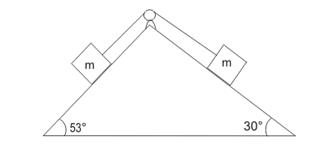Answer:All of the above
Answer:All of the above
Answer:First increases then decrease to zero
| Article and Schedule Quiz | Start Test! |
![]()
Answer:F = mg
Answer:2:5
Answer:First, the inner wheel leaves the ground
Answer:m (v2 – v1)
Answer:r = i(2.5 t2 + t) + j(t - 1.5t2)
Answer:B, C

if Coefficient of friction is μ then what is the least value of μ so the system remains at rest
Answer:0.203

Answer:4F0/3M0
Answer:Velocity and acceleration vectors of a moving particle may have any angle between 0 and 180 between them
Statement A : Newton’s first law in valid from the pilot in an aircraft which is taking off
Statement B : Newton’s first law in valid from the observer in a train moving with constant velocity Which of the following is correct
Answer:B only
| Missiles Mock Test | Start Test! |
| SSC MTS Mock Test | Start Test |
| IBPS CLERK MOCK TEST | Start Test |
| SSC MTS 2022 JULY 26 Shift 1 (ENGLISH) | Start Test! |
| SSC GD Previous Year Paper 2021 Nov 17 Shift - I (Hindi) | Start Test! |
| SSC CGL Tier - 1 PYP 2022 April 21 Shift- 1 (ENGLISH) | Start Test! |
| MPSC PAPER I MOCK TEST 1 (ENGLISH) | Start Test! |
| IB Security Assistant Mock test 1 (english) | Start Test! |
| UP POLICE CONSTABLE MOCK TEST 1 | Start Test! |
| DELHI POLICE CONSTABLE MOCK TEST 1 (HINDI) | Start Test! |